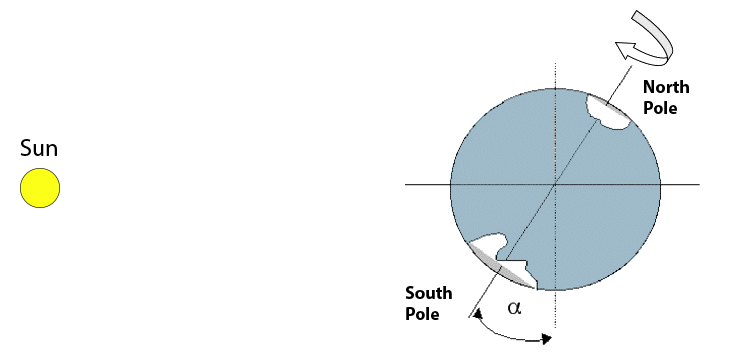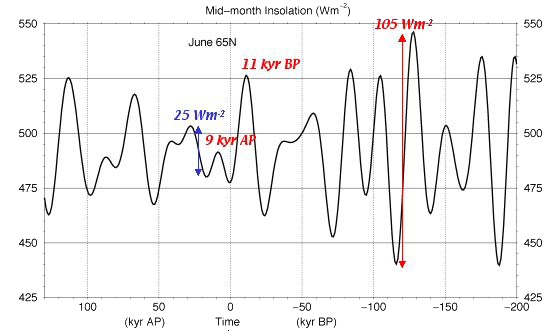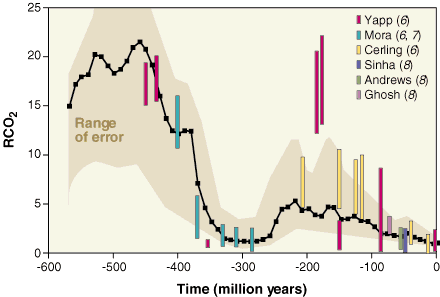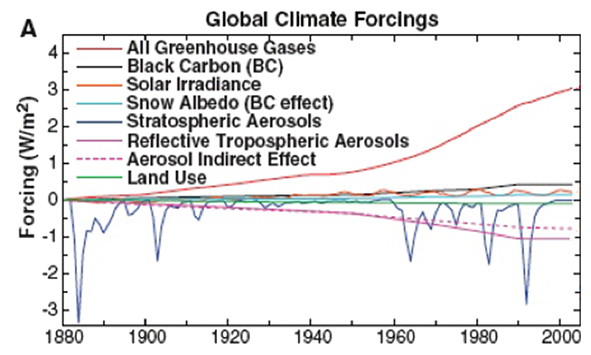In the debate that arises about climate change, there are two assertions that are frequently made though they are not true:
- that man would have become the only cause of climate change,
- that man can influence the climate system only by increasing the greenhouse effect.
Of course, writing that these two assertions are incorrect does not mean that our influence on the climate is negligible compared to natural causes, or that increasing the greenhouse effect is a secondary matter, or has an influence on the climate system which no greater than the other ones we have.
Still, there are other ways through which man can exert an influence on the climate system, just as the climate can also vary under natural causes. Is it possible to have a clearer vision?
Does our climate vary naturally?
Actually, not only is the climate system able to change without any men to influence it, but over long periods of time it has never stopped to do so. There are many factors that influence the terrestrial climate system, and if, nowadays, man has become the main factor, there is a long list of evolutions that can lead to a climate change, among which :
- the climate system can be modified because the amount of energy that the sun sends to the earth can change:
- the energy output of the sun can change. A couple of billion years ago, for example, the solar activity (the term “solar activity” is generally used to designate the energy output of the sun) was 30% lower than what it is today, because the sun was much younger. The solar activity also varies slightly over much shorter periods of time ; there is for example a 11 year cycle in this activity, characterized by a varying number of dark spots on the sun’s surface. However the magnitude of this change is too small to explain the recent global warming.
- under the influence of the large planets of the solar system (Jupiter, Saturn), the characteristics of the orbit of the earth around the sun vary a little over time. This changes the amount of energy that Earth receives from the sun, along with the dispatching of this energy over the surface. Over the last million years, for example, it is the variations of the astronomical parameters of Earth’s orbit that have generated the ice ages, and their ending.
First of all, the “flattening” of the ellipse that Earth follows around the sun varies slowly over thousands years, with a quasi-periodicity if about 80.000 years (which means, so to say, that after 80.000 years the situation is alike a “back to where we begun” regarding this particular aspect).

Illustration of the flattening of the terrestrial orbit with time.
115.000 years ago, for example (an ice age was coming), the orbit was a little flatter than today.
Be careful: the respective sizes of Earth and the Sun are not at all on the proper scale !
Source: Nathalie de Noblet, Symposium du Collège de France, 12 october 2004
Well it happens that the average energy received during a whole year depends on the flattening of the orbit, it’s M. Kepler that said so !
Then the tilting of the earth’s axis on the orbit – called obliquity (see picture below) – varies with a 40.000 year quasi-period.

Obliquity is the alpha angle at the bottom of the picture.
This angle varies with time, losing or gaining 1° in rough figures over a 40.000 period.
A change in obliquity changes the contrast between seasons : the highest value this angle has, and the more energy a given hemisphere receives during summer, and the less during winter. An important obliquity hence results in hotter summers and colder winters.
Source of the drawing : Jancovici, 2002
And at last Earth does not always show the same hemisphere when it is closer to the Sun, or said otherwise it is not always at the same place on the orbit when the equinoxes happen (though it is not faithfully represented below, the equinoxe is the time when the rotation axis of the Earth is perpendicular to the imaginary line that joins the Sun to the Earth, and at that precise moment the duration of the day is exactely the same than the duration of the night everywhere on the planet).

Illustration of the displacement of the solstice along the terrestrial orbit.
(actually the rotation axis should be “rotating” on the drawing and not be tilted the same way on the right image than on the left one, in order to be always perpendicular to the Earth-Sun line when the equinoxe happens).
Source: Nathalie de Noblet, Symposium du Collège de France, 12 october 2004
Because of this “moving” along the terrestrial orbit of the moments when solstices and equinoxes happen, every 13.000 years there is a change of the hemisphere facing the sun when the Earth is closest to it. Terre This process is known as the “precession of the equinoxes”. It plays an important role, because the two hemispheres (Northern and Southern) are very different: the northern hemisphere has more ground, which reflects better the incoming light than ocean water. This way, depending on the hemisphere that faces the sun when the Earth is closest to the Sun, the average energy absorbed by our planet will greatly vary.
In quantitative terms, it is this last effect that generates the largest changes in the amount of energy that we keep from the sun, and that sets the climatic machine in motion.

Variation of the average amount of energy that reaches the ground at mid-june and at the latitude of 65 °north, depending on time.
When going right, one goes back in time (kyr BP means “thousand years before present”). At present times this value equals to 480 Watts/m², and 11.000 years ago (holocene) it was of 530.
One sees that 100.000 years ago, when the excentricity was higher, the consequence of the precession was far more important than today: this value oscillates strongly with a “quasi-period” of 10.000 years.
Source: André Berger, Symposium du Collège de France, 12 october 2004
Those various “astronomical” variations have been the main cause of the major shifts in the global climate over the last 400,000 years (not bad !), and have generated the glacial and interglacial ages:

Evolution of the average temperature over the Antarctic – that is closely correlated to the average temperature of the earth – over the last 400,000 years.
The 0 of the right vertical axis corresponds to the present temperature (this curve actually represents deviations from present values). The deviation over the Antarctic is slightly more important than the planetary change.
Beware ! This curve must be read “backwards”: you go back in time when going to the right. The small oscillations on the left part of the curve is the consequence of the fact that measures are more accurate, and resolution higher, when closer to present times.
Source : Petit & al., Nature, Juin 1999
- The climate system can vary because the composition of the atmosphere changes (even if the change is not induced by man), what changes the greenhouse effect. For example, the onset of life on earth led to a considerable decrease of the atmospheric CO2 (CO2 was the main component of the primitive atmosphere), what gradually decreased the greenhouse effect over a billion years (only the solar activity increased in the same time, and these two processes more or less compensated each other).

CO2 concentrations since the beginning of the primary era. RCO2 is the ratio between the CO2 concentration just before the industrial times (a little below 300 parts per million, that is 0,03% of the volume of the whole atmosphere) and the past concentrations.
For example, R = 5 means that the CO2 concentration is then 5*300 = 1500 ppm, or that the CO2 then occupies 0,15% of the atmosphere.
At the time of dinosaurs (-230 to -65 million years, roughly) the atmosphere had much more CO2 than today (2 to 5 times more) and hence the greenhouse effect was much stronger (but then the sun was sending less energy, so that the average temperature was not considerably higher than what it is today). But the diagram says nothing on what happens when the amount of CO2 is multiplied by 2 to 4 in a century, what never happened naturally !
From Berner, Science, 1997
- The climate can be influenced by volcanic activity. A volcanic eruption puts SO2 into the atmosphere, for instance, and SO2 is a “climate cooler” (see page on aerosols) ; it also puts CO2, which is a greenhouse gas, and if the eruption is powerful enough it can put large amounts of dust in the stratosphere (stratosphere is a layer of the atmosphere that begins 10 km above the ground). This dust darkens the sunlight, hence “cooling” the climate, and will stay “up there” for a significant time (several months or years). One of the hypothesis to explain the extinction of the dinosaurs, for example, has long been a volcanic activity so intense that it would have send considerable amounts of dust in the stratosphere, leading to a cooling of the earth’s surface so important (several ° C) that it would have caused the extinction of a very large fraction of the living species. Actually the hypothesis that prevails today is the impact of a large meteorite, that would have had about the same effect (lots of dust in the stratosphere), but it illustrates that an abrupt climate change can lead to a massive episode of extinction.
- over long periods, the climate system can be modified by the continental drift:
- it is the apparition of a continent at the south pole (that drifted from the tropics) that allowed the building of an ice cap, what influenced in return the climate of the whole planet,
- the continental drift influences the shape of the oceanic basins, what in return modifies the oceanic currents, that carry more or less energy from the tropics to the poles,
- the continental drift has also created mountains, that definitely exert a strong influence on the local climate !
- The climate system also depends on the amount of solar energy that is reflected by the earth’s surface, thus directly sent back to space without fueling the climate machine.This “reflecting power” of the surface, that physicists call albedo, increases with the global ice extent (such as sea ice), increases with desertification (be it natural or not), but decreases when a forest replaces some grassland (forest are generally dark surfaces, except for boreal forests in winter, when they are covered with snow).
It is therefore certain that man is not the only factor of climate change, but the interesting question today is: will humanity be the main factor of climate change for the coming centuries? And the answer to this precise question is: it might well be…
Is increasing the greenhouse effect the only influence of man over climate?
Another question is very frequent in the “climate change affair”: wouldn’t we have other influences on the climate than increasing the greenhouse effect? Actually it turns out that we have many other influences, but presently all the other ones are of secondary importance compared to the increase of the greenhouse effect, if we except the emissions of aerosols (see details on another page):
- man can significantly influence the local water cycle, and thus the local climate, either by building a large dam (this effect has been observed around the Aswan dam, in Egypt), or by supressing an existing water reservoir (in the case of the Aral Sea, for example). A disturbance of the local water cycle is also observed following deforestation (it generally gets dryer).
- urban concentration generates local temperature increases, particularly at night, because of concentrated energy use (heating, air con, traffic, etc) and because of thermal inertia of buildings,
- repeated wood combustion (through repeated forest fires, for example) sends aerosols into the atmosphere, that influence the local cloud formation, and therefore the local hydrology,
- Desertification modifies the albedo of the land, generally leading to an increase of the reflection of the incoming solar light, hence decreasing the local ground heating.
Is it possible to compare these various effects?
All the causes of climate change described above, be they “natural” or of human origin, do not occur at the same pace (the consequence of continental drift on the climate system, over a century, is not very important!). The scientists that work in the various disciplines have examined, of course, how do these diverse effects compare to each other, and how do they compare to the increase of the greenhouse effect.

Evolution of the radiative forcing (that is the “global influence on the climate”) over the last century of various factors, natural as well as human induced.
- “natural” forcings basically include volcanoes (significant when it happens but for a short period of time) and solar irradiance change.
- “human” factors (or “anthropic”) include greenhouse gases and aerosols.
Natural factors, that dominated a century ago, are today marginal considered to human induced factors. It’s clearly a change in the magnitude that will be a source of concern.
Source: Hansen et. al, Science 2005
So far, the conclusion is pretty clear: the human induced greenhouse effect has become the first cause of climate change for the last decades, and might well continue do be so in the next centuries.